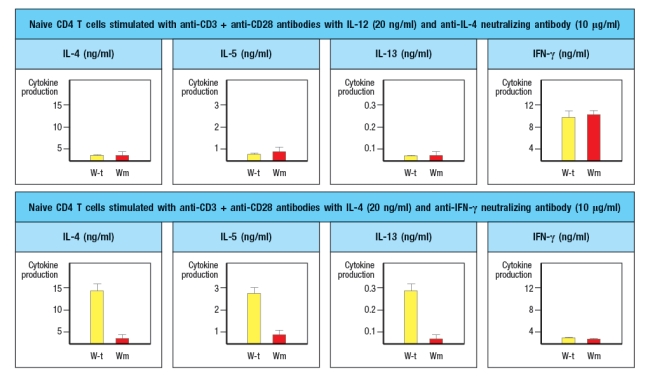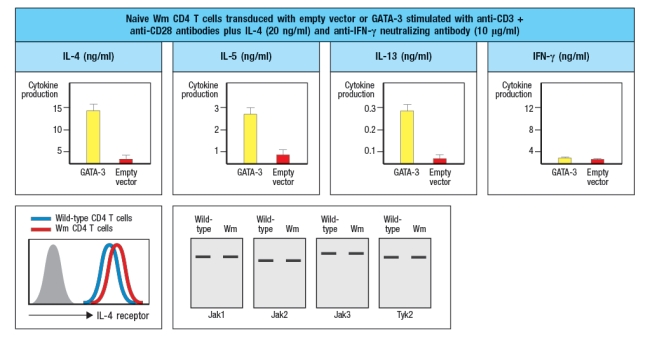A mouse line (called 'Wm') is discovered that has an unexpected immunodeficiency. Genetic studies indicate that the immunodeficiency is due to a single gene defect. The Wm mice have normal numbers of all immune cell lineages, including T cell, B cells, macrophages, dendritic cells, NK cells, and granulocytes. When infected with viruses or intracellular bacteria and protozoa, the Wm mice mount normal protective T cell responses and clear the infections. However, given a helminthic parasite infection, the Wm mice cannot clear the infection and succumb to the disease. A set of wild-type (WT) and Wm mice were infected with the helminthic parasite, Nippostrongylus brasiliensis, and cytokine production by the CD4 T cells was analyzed. For this experiment, CD4 T cells were isolated from mice at day 8 post-infection, stimulated in vitro for 24 hr stimulation with anti-CD3 antibody to elicit cytokine secretion, and then cytokine levels in the culture supernatants were examined by ELISA. The results are shown in Figure. 
a) What process is likely defective in the Wm mice?
b) Which molecules are the best candidates for the defective gene in Wm mice? Note that the transcription factor GATA-3 is not a likely candidate gene, as GATA-3-deficient mice have an early block in T cell development in the thymus, and completely lack all T cells.and Wm mice and were stimulated in vitro with anti-CD3 plus anti-CD28 antibodies, in the presence of additional cytokines and blocking antibodies as indicated. After three days of stimulation, the T cells are isolated, washed, and restimulated with anti-CD3 antibody in medium lacking any cytokines or antibodies. After 24 hr, the cytokines present in the supernatants of these restimulated CD4 T cells are examined by ELISA. These data are show in Figure. 
c) Do these results change your answers to parts (a) or (b) above?
To continue to identify the molecule or pathway defective in Wm T cells, CD4 T cells are isolated from Wm mice and stimulated in vitro with anti-CD3 + anti-CD28 antibodies in the presence of IL-4 and anti-IFN- antibody, as above. One day later, the cells are transduced with a vector expressing the transcription factor GATA3. From this vector, GATA3 will be expressed constitutively and at high levels, in all of the T cells. As a control, an 'empty' vector (not containing GATA-3) is also transduced into Wm CD4 T cells. Three days later, the cells are washed and restimulated for cytokine secretion analysis by ELISA, as above. Additionally, flow cytometry analysis of naive wild-type and Wm CD4 T cells stained with an antibody to the IL-4 receptor was performed, and the results are shown.and Wm CD4 T cells was then performed to examine the expression of the four Jak-family tyrosine kinases required for downstream signaling induced by the cytokine receptors expressed on T cells. The results from these experiments are shown in Figure. 
d) With the new information provided by the data shown above, name the most likely candidate molecule for the defect in Wm T cells, and explain your reasoning.
Definitions:
Pessimistic Explanatory Style
A tendency to consistently interpret and explain negative events as internal (due to one's own fault), stable (lasting over time), and global (affecting many areas of life).
Major Depressive Disorder
A health condition affecting the psyche, evidenced by a sustained gloomy mood or unwillingness to participate in activities, heavily influencing daily routines.
Suicidal Thoughts
Thoughts about taking one's own life, often associated with depression or severe distress.
Depressive Symptoms
manifestations of depression that can include feelings of sadness, hopelessness, and a lack of interest or pleasure in activities.
Q1: Several small GTPases play critical roles in
Q5: Toll-like receptors (TLRs)are a family of homologous
Q6: High-affinity Ig receptor on macrophages and neutrophils
Q11: Although homozygous deficiencies in complement regulatory proteins
Q22: Determine the expected profit for the following
Q26: Salmonella typhimurium is a Gram-negative bacterial
Q30: In the linear trend equation, how is
Q31: Immunotoxin therapy as an anticancer treatment is
Q53: Listed below are the top-steel producing nations,
Q90: i. The moving average method averages out